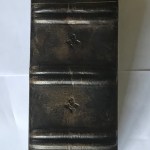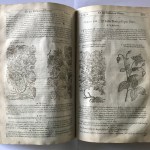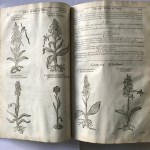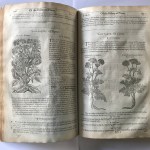GERARD, John. The Herball or Generall Historie of Plantes. Gathered by Iohn Gerarde of London Master in Chirurgerie, Very much Enlarged and Amended by Thomas Iohnson Citizen and Apothecarye of London
London, Adam Islip Norton and Richard Whitakers, 1633.
SOLD
Folio. Title-page, pp. (xxxvi) 1630 (xliv, i.e., 44 out of 48 original pages); missing initial blank and final blank (as usual) and two leaves at the end: 6z6 (from the “Table of English Names”, supplied with two leaves written in a late C18th or early 19th hand), 7b5 (the final leaf with errata). Engraved title-page laid down, lower outer corner torn, affecting the illustration only marginally. Mainly Roman and Italic letter, little Greek and Gothic, very sporadic Hebrew. Head- and tail-pieces, decorated initials (both historiated and floriated). More than 2500 beautiful and accurate botanical illustrations. Early owner’s autograph on verso of second leaf “Wilfrid Browne”. A few extensive tears without loss: 2×6, 3h3 (extensive), 3m6 (extensive but repaired with paper reinforces) and 5e3. Occasional ink spotting and candle burnings throughout, occasional age yellowing and wear to margins, otherwise in very good condition. A thoroughly used book that has remained surprisingly clean and functional. Rebound in modern brown skin over boards; spine in five compartments divided by double sewing support, with gilt-stamped title. Notwithstanding some flaws, a good copy of an important work in the history of botany.
Second edition, perhaps the best and most complete of all. A beautifully and fully engraved title-page by John Payne. This is Johnson’s enlarged version of the botanist’s major work, first published in 1597. The London apothecary Thomas Johnson (c.1595-1644) revised the original work, making it possible to distinguish his additions. This edition brought a new and more scholarly focus to Gerard’s Herball. Indeed, it was greatly esteemed and reprinted in 1636. It is extensively illustrated and Johnson drew several of the diagrams himself. The woodcuts included in the first edition were printed from wood-blocks obtained from Frankfurt, which had been used to illustrate the “Eicones plantarum” of Taberaemmontanus (1590). Johnson supplemented these with superior illustrations from the stock of Antwerp’s famous printer Plantin. “Gerard contributed greatly towards the advancement of the knowledge of plants in England, and in his Herball he described and illustrated several hundreds of our native flowering plants, including about 182 which were additional to those recorded in earlier works” (Henrey, p. 47).
Henrey 155; Nissen BBI 698; STC 11751.









